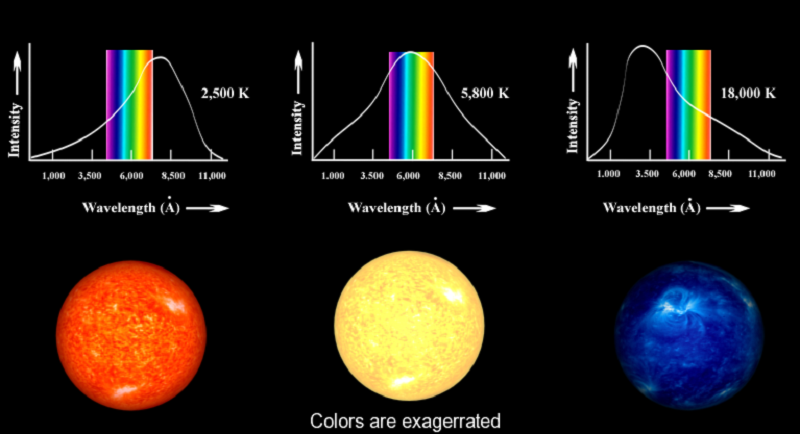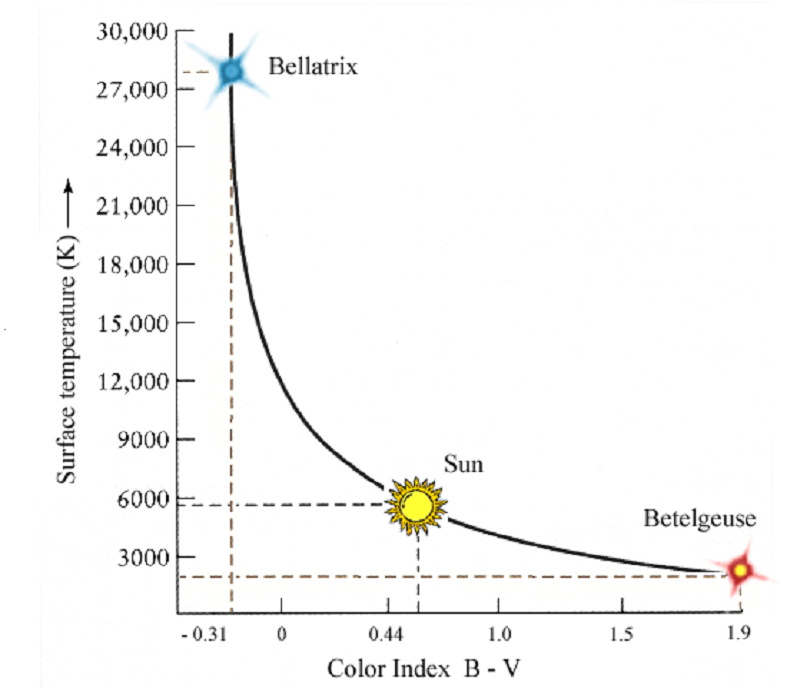If you look up into the night sky you may be able to see a few thousand stars from a dark site. As the stars are all so distant they appear as points in the sky. Most appear white, but a few stars, such as Antares and Betelgeuse, have an orange or reddish hue to them; others such as Rigel suggest a bluer color.
The color of a star is primarily an expression of its temperature. A star’s behavior is similar to that of a black body radiator; as a black body gets hotter, its color changes. If you were to heat it up, it would first emit radiation in the infrared region. Further heating would see it glow a dull reddish color. More heating could eventually glow orange, yellow, white and eventually blue-hot. Ultimately if it were hot enough, a black body emits most of its energy in the ultraviolet region. Although stars are not perfect black bodies this relationship between temperature and color still applies to them.
Although cosmic dust only makes up 1% of the interstellar space mass (ISM), it absorbs and scatters light from stars. Interstellar space is not a perfect vacuum; ISM comprises cold neutral gas, warm neutral gas and hot ionized plasma. Cosmic dust is made up of small grains of silicates, iron, carbon, frozen water and ammonia ice. This means that light from a distant star is reduced in intensity so that the star appears dimmer than it would be if there was no intervening material.
Termed extinction, this effect is inversely proportional to wavelength so red light is less affected than blue light. More distant stars suffer greater extinction or reduction in brightness than nearby stars. Extinction distant stars thus appear redder than they actually are.
Red giants such as Betelgeuse are not actually that red in color; its actual color is more orange than true red. A small group of stars do, however, appear deep red; these are carbon stars. These ruby-red colored stars have high abundances of carbon molecules, such as C2, CH and CN, in their outer layers that absorb most of the photons in the blue and violet parts of the spectrum. Nowadays, they are collectively referred to as type C (for Carbon).


Stars are classified by their spectra; that is, the elements that they absorb, and their temperature. There are seven main types of stars. In order of decreasing temperature, they are O, B, A, F, G, K, and M. O and B stars are uncommon but very bright, while M stars are common but dim.
The Hertzsprung-Russell (H-R) Diagram is a graph that plots stars’ color; its spectral type or surface temperature versus its luminosity. On it, astronomers plot the stars' color, temperature, luminosity, spectral type, and evolutionary stage. This diagram shows that there are 3 very different types of stars:
- Most stars, including the Sun, are “main sequence stars” that are fueled by nuclear fusion converting hydrogen into helium. These stars are in the most stable part of their existence. This stage generally lasts for about 5 billion years. The hotter these stars, the brighter they are.
- As stars begin to die, they become “giants” and “supergiants”. These stars have depleted their hydrogen supply and are very old. Their cores contract as their outer layers expand. These stars will eventually explode to become planetary nebulae or supernovas, depending on their mass. Eventually, they will become white dwarfs, neutron stars, or black holes, again depending on their mass.
- Smaller stars like our Sun eventually become faint “white dwarfs”. Having depleted their nuclear fuels, these hot, small, very dense shrinking stars are made mostly of carbon. These stars are what remain after red giant stars lose their outer layers; they eventually lose their heat and become cold, dark “black dwarfs”.
References